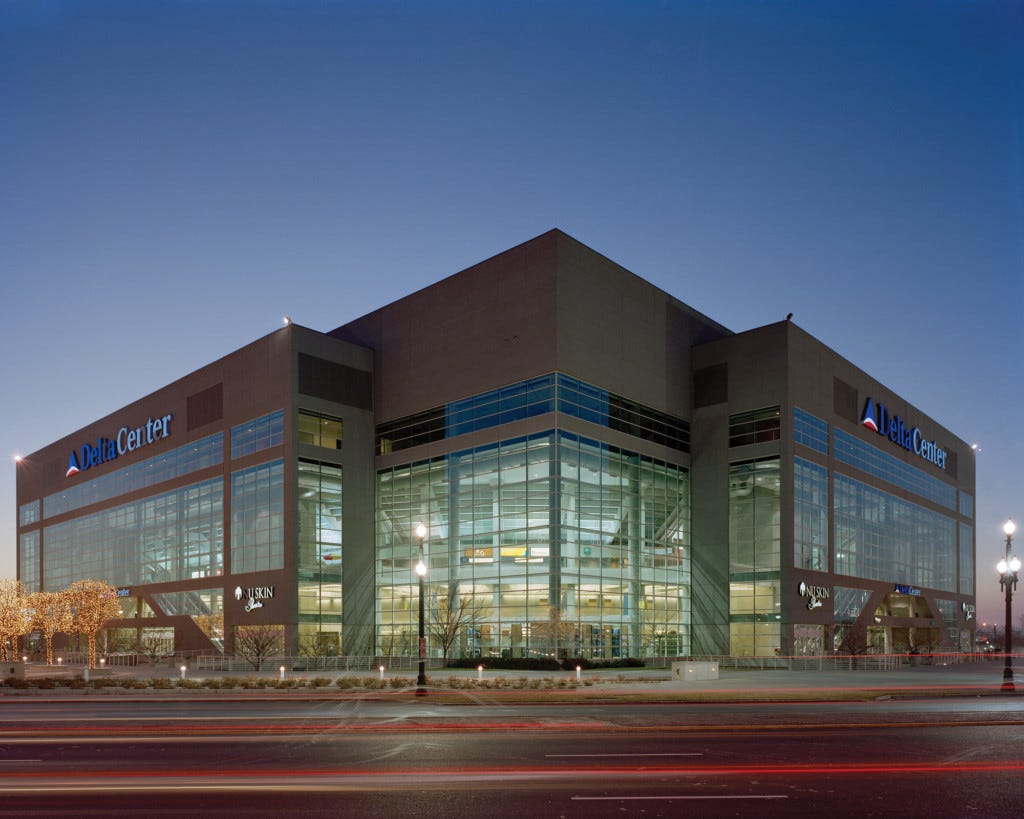Shootaround Drill
6/8/95, Delta Center, Salt Lake City, UT

The Delta Center is an enormous arena, the home of the Utah Jazz both then and now. Capacity figures range from 12,000 to 18,306, which are the kinds of numbers Phish could pull off for special holidays on the East Coast by the end of 1994, but punches well above their weight class on the western side of the US. For reference, Red Rocks, for which these first two shows were pretty obviously an unofficial warmup, is about half the size of that upper estimate.
It’s no surprise then that this outsized venue was an unplanned backup, after weather forced the relocation of this show from the smaller Wolf Mountain Amphitheater in nearby Park City. That venue, which Phish would eventually play to kick off the US leg of next year’s summer tour, seems to be lost down the internet’s memory hole. But whether it’s this bubble-dome or this bandshell, it’s hard to imagine a ski resort’s summer concert space holding the same amount of people as the SLC home court of Stockton and The Mailman.
Even if all of those Wolf Mountain ticketholders made it over to the Delta Center with only 24 hours notice, the Delta Center was probably pretty empty on this night. But when the lights are down, you can’t see past the first few rows anyway. So Phish could consider this an early-year dry run for the sort of NBA-class arenas they’d frequent in the fall and winter — they’d go on to play the current or former courts of the Trail Blazers, Hornets, Pistons, 76ers, Wizards, and Knicks by year’s end. But after this show, they’d be outdoors for the next four months.
So tonight is a low-stakes opportunity to test their adaptations for big rooms. There are technical aspects to fiddle with: a new stage setup that debuted the night before, with the last of the Minkin backdrops trimmed to narrower strips to give Chris Kuroda’s lights more breathing room, and further iterations on Paul Languedoc’s sound system for larger arenas (on the evidence of this very nice AUD, he’s figuring it out quickly).
But more germane to my interests are the musical decisions inspired by the environment. On paper, there’s a shift towards simplicity — no fussy epics such as Fluffhead, You Enjoy Myself, or Divided Sky, but plenty of riff-rockers, including the third Ha Ha Ha in three 95 shows, the second Free, and the year’s debuts of Chalk Dust Torture, Simple, and Julius. Prince Caspian, making its debut tonight, is the most arena-tuned of the fresh material, built on a simple chord strum and a bunch of big “OHHHHHHH”s to echo off the rafters. Set closers Chalk Dust and Julius are both played blisteringly fast — hell, everything’s pretty fast — and Chalk Dust has one of those long, sustained notes that would become a Trey-demark (sorry) of this era. There’s no Fishman song, no acoustic songs, minimal hijinks. They encore with Zeppelin, natch.
A more direct setlist isn’t really a problem so long as the playing remains adventurous, and two performances in this show are highly reassuring. In the first set, there’s Reba, the proggiest song played on the night, and while the composed section is a bit flubby, the jam is already in midseason form. The biggest fear with an arena atmosphere is that it would sabotage the band’s patience, but the band burbles calmly and confidently for several minutes before starting the ramp up to a soaring, well-earned peak. It’s a shimmering version that would feel right at home on the theater circuit, and there’s no degradation in a more spacious venue — if anything, Trey’s fireworks at the end are all the more emotionally powerful with that extra arena reverberation.
Conversely, the Tweezer that centerpieces the second set does sound different from its plus-sized brethren from the year before. The 22:40 length might put it in the ballpark of the lengthy Fall 94 versions, but this incarnation is more direct, without the long detours of avant-garde experimentation of Bangor or Bozeman (apart from the cartoon-jazz “Sabre Dance” segment in the middle), and more organic, avoiding a heavy-handed change-of-direction every couple minutes. Instead, it’s closer to a modern version, trying on a succession of grooves or textures and sticking with them until they wear out. Just when it seems like it’s winding up, it’s suddenly possessed by a premonition of fall 95; from 21:15 to the end, it’s 90 seconds of swagger you don’t often find in Phish before this point. (Here’s where I’d like to loop it back to the NBA metaphor, but the 90s Jazz were the absolute inverse of swagger, so oh well).
My hunch is this more focused, but still extended, improv is another result of their A Live One curation duties. It reminds me of one of my favorite Phish Book quotes, from Page, who commented about late 94:
But a lot of those jams weren’t very good in the end. When we were choosing material for A Live One, I’d hear these Bowies, Tweezers, and Antelopes and think, “That’s a good moment there, but man, the next five minutes kind of drags.”
Sacrificing a percentage of their weirdness in favor of bigger gestures feels like a fair compromise, as the band moves up a tier in the touring biz. Dragging that slider back and forth to find just the right balance between those competing interests will be one of the main narratives of 1995, and happily we already know it ends in triumph. But it’s heartening to hear that even in this early-year arena-rock dress rehearsal, they’re already well on their way.
